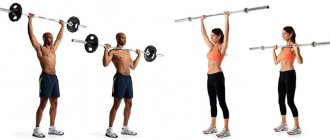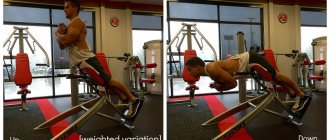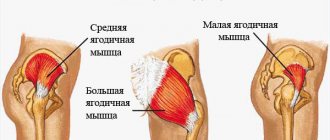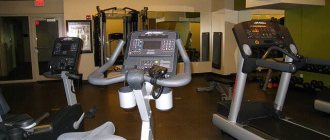The desire to gain a beautiful and sculpted body encourages a person to engage in strength training, but progress in exercise is noticeable for everyone in different ways. For some, it is enough to visit the gym twice or thrice a week to achieve excellent results. Others calmly go to the gym every day, look and feel great, even taking into account the fact that most sources write that the muscles need to be given time to recover. And if you want to achieve your goals in a short time, the issue of the relevance of daily training comes to the fore.
How long does it take for the body to recover?
The human body needs to rest. Otherwise, a state of overtraining will occur, when even the most ideally selected training program will not bring results. The minimum recovery period is one day. Twenty-four hours after training, the body becomes completely ready for the next session.
This condition does not affect everyone, but only affects the following groups of people:
- beginners, that is, those who have recently started training;
- older athletes who are already fifty years old or older;
- amateurs who do not plan to achieve any serious sports goals.
The days between two workouts are necessary for the body to regenerate, produce enzymes, produce new muscle fibers, and gain sufficient energy.
The maximum allowable time that a person can devote to training on exercise machines without rest is three days. This mode without interruption is only suitable:
- actively pumping up the muscles of the arms, legs, and back;
- professional athletes working with heavy weights.
These recommendations should not be taken as absolute truth. Each person’s body is individual, so the specific period for recovery is determined together with experienced trainers and mentors, but if we are talking about independent training, you should not neglect the advice.
Is it possible to train EVERY DAY?
Abdominal muscle corset
Yes, yes, yes - these are those treasured abs and they consist of:
- Rectus muscle tissue is the strongest and largest, the same “washboard” on the stomach. Responsible for twisting the body in the lower back.
- Oblique muscles (external and internal) - located under the ribs and cause the body to turn left and right.
- Transverse muscle tissue - located in the lower abdominal region across the rectus muscle. A rather finicky muscle fiber, it is what prevents the appearance of cubes in the lower abdomen.
We wrote earlier how to pump up your abs without effort.
Frequency of training each muscle group
Increasing muscle volume and definition is a goal that can only be achieved with a regular and continuous training cycle. Long breaks minimize effort, so rest breaks should be determined for your specific case. This does not mean that you can simply choose a certain time yourself, since there are rules that cannot be ignored.
The larger the muscle group, the longer it takes to recover, since it requires much more work and load. Therefore, training that combines small and large muscle groups is incorrect. For example, you cannot train your legs, biceps and shoulders at the same time. This is due to the size of the former.
The legs account for about fifty percent of the total muscle mass of the whole body. And if you combine training of the lower extremities with other groups, this will not bring effectiveness, since it will not be possible to work out either small or large muscles, since the load applied will not be enough to pump in both directions. Such a large muscle group as the legs should be given a separate training day. In addition, it should be taken into account that they will need much more rest than the arm muscles.
Small muscle groups, which include the shoulder girdle, biceps, triceps and others, recover faster, so they can be trained more often. The shoulders, for example, are involved in pumping the pectoral muscles, which in no way contradicts the principle of proper recovery after training.
Training 4 or more days a week
If you're going to be training almost every day, you'll need to be very conservative with each workout. Choose three big exercises and limit yourself to two or three sets, avoiding failure. Treat each set as practice, working with a weight that feels moderate. This will help you become incredibly strong and pumped up.
A frequency of 4 or more days per week is great for performing exercises such as squats and bench presses. That being said, be careful with any isolation lifts you want to use with this approach.
Four or more training days on the same muscles is taxing, especially on your joints, and even something as innocuous as curling your arms can lead to sore elbows or shoulders. So, Ferrugia recommends not performing any isolation exercises for the first three to four weeks.
How much rest do beginners need?
People who have just started working out may rest less than their more experienced gym mates. This is due to the training program itself. Experienced bodybuilders lift heavy weights and perform complex variations of exercises, which is why the load on the muscles is much greater.
Beginners don't use their muscles as hard because they simply can't handle the pace. The absence of maximum loads allows them to devote much less time to rest, but only until they become experienced bodybuilders. Those who have recently come to the gym after pumping up large muscles can recover from 1.5 to 2 days, and experienced ones - from 48 to 72 hours.
What happens if you train EVERY DAY?
Back muscles
Large and strong spinal muscle fibers are a dream come true. Here three types of muscles receive attention and elaboration:
- Trapezius – the absence of trapezius muscles spoils the whole picture of a gorgeous body. They are responsible for raising and lowering the shoulders.
- The latissimus dorsi muscles, also known as the “wings,” give visual width to the entire back. The “forgot the watermelons at home” gait perfectly demonstrates good lats, if, of course, they are present. They pull the muscles of the upper limbs backward.
- The long muscles of the back are simply the lower back. These two columns of muscles on the two sides of the spine flex and extend the body in the lumbar region.
Recovery for experienced bodybuilders
Takes much longer. Experienced athletes train intensively and intensively. They work at a pace that comes with experience, which greatly increases the load on the body. To increase the effectiveness of training, bodybuilders work on a certain part of the torso at a time, loading each to the maximum.
This split principle allows you to allocate a specific period for individual muscles and load them to the maximum. In addition, this gives you the opportunity to have quality rest for a whole week. Thus, it turns out that training for each group is repeated once a week, when they are fully restored.
Main Factors
How often can you train one muscle group? Let’s say right away that everything here depends on recovery – our body’s ability to replenish spent energy resources and “rebuild” damaged muscle fibers.
Recovery abilities depend on many factors, but the most important of them are the following:
- degree of severity of the training session (selected weight, intensity, duration, etc.);
- the general level of physical fitness of the athlete (training experience, degree of perception of physical load).
Important points to remember
Arnie, one of the most outstanding bodybuilders in the world, never missed an opportunity to train, and devoted absolutely every free minute to training. Of course, to reach such a high level, he went through quite a long journey, which allowed him to train up to several times a day. It is certainly possible to follow in the footsteps of the famous bodybuilder, but do not forget that Arnie did not immediately become strong.
As a newbie, he went to the gym no more than two or three times a week. Once his body got used to the stress, he increased the number of training days. Any other experienced athlete can do the same, but only when the muscles do not ache or ache. In addition, one should take into account the fact that victories in competitions, fame and money became an excellent incentive for him to maintain his shape.
In the world of professional bodybuilding, competition is quite fierce and every athlete strives to become better. This was the main reason that Arnie had to completely revise his training plan, increasing the intensity and frequency of training. Some bodybuilders take steroids with proteins, which allow them to speed up recovery processes and also quickly adapt to increasing loads.
The key to the success of successful bodybuilders is that they are completely able to concentrate on the training process and not be distracted. They can push themselves to the point of exhaustion even when lifting light weights because they have a clear idea of the result they want to achieve.
Another important point that absolutely all beginners should take into account is that without rest days they train inconsistently, but only three or four weeks before the competition.
Shoulders
Here we will not talk about the deltas that cover the shoulder joint from above, but about the muscles of the rotator cuff. They stabilize the joint and are often ignored.
By training them every day, you will reduce the risk of injury and increase your performance in a variety of upper body exercises.
Alternate doing it every other day. On training days, do one approach as part of the warm-up before the main movements, on rest days - 2-3 approaches.
Raising your arms to the sides
Take light pancakes of 1.25 kg each, turn your hands with your palms facing your body. Squeeze your shoulder blades and lower your shoulders - this is the starting position.
Raise your arms straight to eye level, turning your hands with your thumbs up. It is important that the arms do not rise clearly to the sides, but slightly forward (with an abduction of approximately 30° in the horizontal plane).
Hold the last position for 1-2 seconds and lower your arms. Do 15–20 reps.
Turn outward
For this exercise you will need an expander. Hook it onto the counter, turn sideways towards it and bend your working arm at the elbow at a right angle. Overcoming the resistance of the expander, turn your forearm outward and return it back.
Don't raise your shoulder, keep your elbow close to your body. Perform 15–20 times with each hand.
Lead on the block
For this exercise you will need a resistance band or a pulley machine. Hook the band onto a counter or grab the handle of an exercise machine and get down on one knee. Lower your shoulders and squeeze your shoulder blades together, grab the expander or handle of the exercise machine so that your straight arm is extended forward at shoulder level.
At the same time, move your shoulder to the side and bend your arm to a right angle at the elbow. Your shoulder and forearm are now parallel to the floor. Then rotate your forearm upward without changing the position of your elbow.
Straighten your arm up, trying to keep your shoulder and shoulder blade in place, and then return it to the starting position, going through all the points in the reverse order.
Perform 10–15 times on each hand.
Training plan
If you are going to become the owner of a beautiful, sculpted body, you need to have a clear training plan and follow this program.
Pumping a specific muscle group every seven days
It might look like this:
- Monday - chest;
- Tuesday - back;
- Wednesday - rest;
- Thursday - legs;
- Friday - shoulders.
They rest on Saturday and Sunday. Thus, it turns out that only one large muscle is worked during the week, and then it is restored over the next week. The main thing is that specific muscles are loaded on each day.
The load on the muscle should be maximum. Otherwise, the training day will be wasted, and this will slow down the development of pumping. You can't strain yourself too much. It is necessary to maintain a good balance in order to be fully restored and full of energy before the next lesson.
Torso pumping
Carried out three times a week - Monday, Wednesday, Friday. The entire torso is loaded. The remaining days are devoted to rest. This training scheme creates a good load, but no stress. With a three-time training scheme for the entire torso, you should do from 3 to 4 sets for each muscle group within one session. In other words, the total number of approaches is 9-12.
Two-day training plan per week
On Monday and Thursday the upper torso is pumped, and on Tuesday and Friday the lower torso is pumped. Wednesday, Saturday, Sunday are days off.
It turns out that each muscle group has a separate training day. This is an intermediate option between the first and second training schemes, which allows you to avoid both excessive and low loads.
The number of approaches for each category of exercise varies from 5 to 6. The pace is chosen moderate, which allows you to maintain frequency and volume without any extremes. The total number of sets per week is 10-12.
Is it possible to train every day? 5 DETERMINING FACTORS!
Press
Daily ab workouts are a great way to see your six-pack quickly.
Choose one exercise and do 3-4 sets of 40 seconds of work. The next day, do the second, after knocking - the third, and then all over again.
Crunches
An effective and safe exercise for the back. Lift only your shoulder blades off the floor, leaving your lower back pressed.
Leg raise
Lift your pelvis off the floor and return it back. You can place your hands under it to make the exercise more comfortable.
Holding the boat
Lift your shoulder blades and legs off the floor. If after a while you start to shake, this is normal. Keep it as long as you can.
You can also supplement your workouts with other abdominal exercises. Don't be afraid to overload your muscles: any movement other than the CrossFitter GHD full extension does not require a long recovery.
See abdominal exercises











